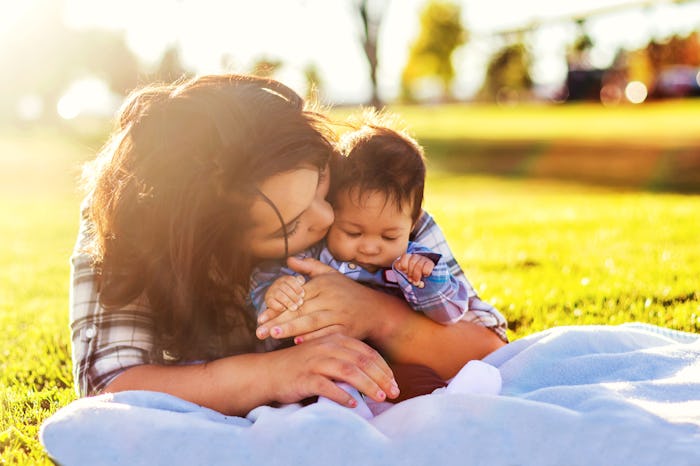Life

When Sunscreen Isn't An Option, Here's How To Keep Your Tiny, Diapered Vampire Safe
Normally, the sun is a welcome delight, wherein after the long gray days of winter, one may bask its beaming rays...
Unless you have a baby who isn’t old enough for sunscreen. Then the sun becomes your archenemy to battle from dawn to dusk. When SPF is a no, it can be a fraught, sweaty exercise in anxiety trying to keep UVA rays from making contact with your delicate baby's flesh. It’s like being the parent of a tiny, diapered vampire. So what do you do, exactly? How do you keep a baby under 6 months safe from sunburn if you can’t smear them in Banana Boat?
The Food and Drug administration says kids in this delicate age bracket shouldn't be exposed to the chemicals in sunscreen, and so they recommend that they are kept out of direct sunlight altogether. But if you aren’t in fact a mole person who lives in a subway tunnel, and you insist upon venturing out into the light, the FDA suggests you keep your baby in the shade — either under a stroller canopy or an umbrella.
Another basic: dress your baby in long-sleeved shirts and pants. Just make sure it's all lightweight, so they don't get overheated. FYI: Linen is actually a not-so-great fabric in terms of sun protection. So if you were planning to dress your infant like she just bought her own villa in Italy and is now on a journey of self discovery, think again. A better option would be one of these full body swimsuits from Coolibar, which is made of UPF 50+ fabric. Pair it with these rad baby sunglasses, and look! It’s a baby Elton John!
A wide-brimmed hat or bonnet is also a must to protect tiny faces and necks. (And I mean really, any opportunity to dress your child in a bonnet before they are old enough to refuse should not be missed.)
The American Academy of Pediatrics does say that if you are somehow unable to procure either suitable clothing or shade, it is OK to use a "minimal amount of sunscreen with at least 15 SPF on infants under 6 months to small areas, such as the infant's face and the back of the hands. Remember it takes 30 minutes to be effective." But again: the FDA isn't a fan, as it thinks sunscreen should be avoided until a child is at least 6 months. (If you feel confused about which way to fall on this, it's good idea to reach out to your own pediatrician for his or her thoughts.)
Other things to bear in mind: the sun is at its strongest between the hours of 10 a.m. and 4 p.m., according to the American Skin Association. So schedule those trips to the playground and park for either early morning (you know you're up anyway) or late afternoon. And remember — an overcast day doesn't mean you're safe! One of the worst sunburns I ever got in my life was in Ireland, when the sky was the color of sidewalk. So remember to use caution even on cloudy days. Parents should also be extra cautious around sand, water, concrete, and snow, as UV rays bounce back on these surfaces, upping the risk of a burn.
If all else fails and your baby still somehow gets a little pink, the AAP suggests applying cool compresses. (Also, might I suggest you apply a cool compress to your own forehead, as you are no doubt beating yourself up relentlessly... even though you did everything short of wrapping your child like a mummy.)
Hang in there, that little guy will be old enough to be slathered in sunscreen before you know it! And then you can enter the next phase of parental insanity: attempting to apply lotion to a squirming, squealing, already-running-away-from-you toddler.